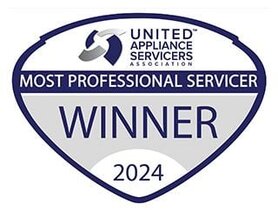Why and How to Clean a Refrigerator Condenser
You’ve likely heard at some point — either from the salesman who sold you your refrigerator, a repair tech, or just a know-it-all relative: “Don’t forget to clean your refrigerator condenser or your refrigerator will break down.” Is this fact or overblown fiction?
Fact. They weren’t steering you wrong, you do need to clean your condenser regularly to keep your refrigerator operating effectively. Oh, you have more questions?
- What is a condenser and why is it so important?
- Will cleaning it actually increase the life of my refrigerator? Or just keep it from breaking?
- So how do I clean it and how often?
Yeah, we can help answer why and how to clean a refrigerator condenser.
How Refrigerators Work, or Why Condensers Are So Darned Important
It’s a little technical, but we’re going to do our best to explain the job of the condenser in a fun, simple way. It’s also really cool, so give it a shot.
The first thing to know is that a refrigerator works by removing heat from inside the refrigerator, leaving nothing but cold air behind.
It’s the same way ice cools down your drink: the ice absorbs heat from your drink, causing the ice to melt. And back in the old days, that’s exactly how things were kept cold: putting them on ice. Problem is, once the ice melts, your cooler stops working.
So engineers in the early 19th century invented what would become the modern refrigerator, designed around a “vapor compression refrigeration cycle” (ah! jargon!), which is as close to a perpetual motion machine as man has ever made. This cycle has three main components:
- The evaporator
- The compressor
- The condenser
Before getting into how it works, first, let’s refresh your memory of a few important items you learned back in high school:
- Heat = energy. As energy increases, things get hotter.
- Liquids and gases are both made of molecules. The molecules of liquids have less energy (which you feel as temperature) and so they lounge about, lazily packed together. As these molecules gain heat and energy though, they get feisty and push each other around, eventually turning into a loosely packed gas. That said, gases are not always hot and not always loosely packed.
- Heat is like your friend who is always complaining that it’s too hot, it will do whatever it can to cool itself down. Often this involves giving off its heat to less hot things.
So, bearing that in mind, let’s start the process in the evaporator, which is a series of coils inside your refrigerator compartment. The refrigerant enters the evaporator as a cold, partly-vaporized liquid—think of it like a cold mist blowing through town. A fan blows air from inside your refrigerator across these coils and, because the refrigerant is colder, it absorbs the air’s heat—just as that cold mist steals heat from your body.
The now colder air is then returned to the refrigerator box, while the warmer refrigerant continues to absorb heat until it reaches the end of the evaporator, at which point it is still slightly below the temperature of the refrigerator interior. At this stage, it has absorbed enough heat to become a full-on vapor. This is why it is called an evaporator, because it e-vapor-ates the semi-liquid refrigerant.
This vapor then enters a compressor that, given its name, is a pump that compresses the molecules of the vapor together. This has the effect of superheating the refrigerant, because all of the vapor’s heat energy has been pooled together in a tiny space. The compressor is what actually drives this whole process (hence “vapor compression cycle”) and is the key to how you think about refrigerator maintenance, as we will see later.
This superheated vapor then enters the condenser, which is a series of coils outside the main refrigerator box exposed to the room temperature air. Because the vapor is much hotter than the air of the room, heat does its thing and escapes, cooling off the vapor. Some condensers also have a fan to blow air across the coils, to increase heat loss. By the end of the condenser, the vapor has cooled to slightly above room temperature and condensed back into a liquid.
At this stage, it passes through a metered capillary tube (which, like the capillaries in you body, is very narrow) before hitting the larger tubes of the evaporator. When this happens, all the closely packed molecules in the liquid quickly fly apart to fill the space, losing a lot of energy (heat) in the process and creating the cold, partly-vaporized liquid with which we began the process. That liquid goes back into the evaporator and the cycle begins again.
Your refrigeration system is completely sealed and so doesn’t leak or lose refrigerant in any way.
- If anyone’s selling you that you need to replace the refrigerant, run! They’re trying to scam you. The only time refrigerant needs replacing is if there’s a leak in the system, in which case the leak is your problem.
- That said, some techs misdiagnose inefficient compressors as a refrigerant leak and add refrigerant, which will only accelerate the failure and cost more in terms of electricity in the process.
This is why you should always trust your appliances to trained experts.
How Can Things Go Wrong With My Refrigerator?
There are actually very few moving parts in your refrigerator: it’s mostly all refrigerant moving through different size tubes. With just a little maintenance, the cycle can go on and on for years.
The one link in the chain that is liable to break is the compressor, which does have an end of life. And most refrigerator maintenance and repair is about reducing the wear and tear on your compressor. For instance, most maintenance checks include examining door seals to make sure warm air isn’t creeping back into the fridge, forcing the compressor to do more work.
But far and away the main culprits to reducing the lifespan of refrigerator compressors across the globe are dirty condensers. The condenser is one of the few exposed elements of the refrigerator and its coils form a perfect trap for dust, dander and other dirty things blowing around your house. That’s why it’s called a condenser clean, because condensers get pretty horrifying. We’ve found enough fur to make a dog out of. We’ve found dead mice. We’ve found snakes.
All that junk forms insulation around the coils of the condenser, preventing heat from leaking from the system. Sometimes, it also traps what heat does escape right around the compressor—we’ve found burnt flooring from years of trapped heat.
Both force your compressor to work harder and longer to cool your refrigerator down, and that’s bad news. For starters, this costs you money in terms of electricity, because your refrigerator has to run longer. It shortens the life of your compressor and your refrigerator in general—if that compressor has a 10,000 hour life, you burn through it twice as fast if it has to run 14 hours a day instead of 7. And, if the refrigerator can’t ultimately cool itself down, it’ll spoil a lot of food.
So, for everybody’s sake—your wallet, your refrigerator, your family, and the environment—clean your condenser!
So How Can I Keep My Condenser Running Efficiently?
If you’re up for it:
- Locate your condenser—many are below the refrigerator or on the back, higher-end units often place the condenser on the top to keep “heavier-than-air” debris out.
- Remove the grill
- Get out a vacuum with “tight-spaces” attachment and go to town
- Then brush down the condenser to remove any more stubborn dirt
Unfortunately, fridge manufacturers don’t always make the job easy. Bottom and back condensers are a pain to reach. And some manufacturers, in an effort to find more creative ways to increase food storage, have tucked the condenser away.
Plus, did we mention what you may find around your condenser is often really horrifying?
So if you’re not up to it, many appliance repair companies (like Hometown Hero Appliance Repair) offer refrigerator maintenance services. Ours, for instance, include:
- A condenser clean
- Door seal inspection
- Temperature and temperature sensors inspection
- OEM water filter replacements (these need to be regularly changed to keep ice and water clean). Note: always rely on OEM parts, aftermarket filters can cause poor water flow, causing flooding and breaking icemakers









